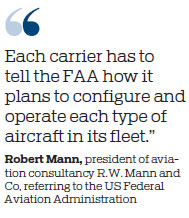Airlines 'allowed' to pick 737 Max jet safety devices
Plane giant Boeing followed US rules for minor modifications, say analysts
The United States Federal Aviation Administration allows airlines to make minor modifications in previously certified aircraft to meet their operational needs, a rule aircraft giant Boeing followed when building the beleaguered 737 Max jet for foreign carriers, aviation analysts said.
On March 10, 157 people aboard an Ethiopian Airlines flight perished soon after takeoff from Addis Ababa International Airport. The disaster followed the crash in October of a Lion Air flight in Indonesia using the same type of Boeing 737 Max jetliner, in which 189 people died. There were no survivors.
The two carriers reportedly declined to buy two add-on safety devices that might have helped the pilots keep the Boeing jets in the sky. A number of other airlines chose to purchase the "angle of attack" system display for readings of two sensors and a "disagree light" to be activated if the sensors produce conflicting readings.

Ethiopian Airlines CEO Tewolde Gebremariam said it was important not to confuse safety-critical equipment with optional items, Reuters reported on Sunday.
"A Toyota is imported with all the necessary equipment to drive, like the engine and the wheels, but with air conditioning and the radio optional," Tewolde said.
"When Boeing supplies aircraft, there are items which are mandatory for safety, and then there are optional items," he added, noting the angle of attack indicator was optional.
Another Ethiopian Airlines executive, however, criticized the software on the Max.
"After the crash, it came to our attention that the system is aggressive," said Yohannes Hailemariam, vice-president for flight operations, Reuters reported on Sunday.
"It gives a message of stalling, and it takes immediate action, which is faster than the action which pilots were briefed to take by Boeing," said Yohannes, himself a pilot with more than 30 years' experience, including flying the Boeing 777 and 787.
Boeing also is faced with the first publicly announced cancellation of an order for the Max 8 aircraft. Garuda Indonesia, the national airline of Indonesia, said on Friday that it told Boeing in a March 14 letter that it wants to cancel a $6 billion order for 49 of the 737 Max 8 jets, saying passengers have lost confidence in the aircraft following the two deadly crashes. Boeing declined to comment.
The New York Times on Saturday reported that Boeing produced the Max planes in response to competition in 2011, when longtime customer American Airlines considered placing orders with European rival Airbus.
"The competitive pressure to build the jet - which permeated the entire design and development - now threatens the reputation and profits of Boeing, after two deadly crashes of the 737 Max in less than five months. Prosecutors and regulators are investigating whether the effort to design, produce and certify the Max was rushed, leading Boeing to miss crucial safety risks and to underplay the need for pilot training," the newspaper reported.
As to the planes' safety features, "these are buyer-specific options", Robert Mann, president of R.W. Mann and Co, an aviation consultancy in Port Washington, New York, told China Daily.
"Each carrier has to tell the FAA how it plans to configure and operate each type of aircraft in its fleet. The FAA is comfortable with low-spec and high-spec airplanes -that's evident. There are lots of issues here, but I don't believe any of them are nefarious," he said.
Scott Hamilton, managing director of Leeham Co, an aviation consultancy in Seattle, told China Daily that the FAA should have mandated both safety features.
"I think it was a poor decision not to include both as standard equipment," Hamilton said. "There are other safety lights in the cockpit, so why not here? This could overwhelm the crew with too much information, but a properly trained crew should be able to handle multiple warning lights and emergencies. There have been instances where that's been the case."
Hamilton said he did not know the cost of the two safety features, but noted it would be an insignificant percentage of a $120 million plane.
Two US airlines flying the Boeing 737 Max - American and Southwest - purchased the two optional safety features. A third - United - did not order the optional equipment. The airline said flight crews use other data to assure safety while in the air.
All US flights using the aircraft have taken off and landed safely since Boeing introduced the plane in 2017.
In a statement, the FAA declined to say why some equipment is required while other devices are not, but noted: "The optional angle-of-attack sensor is not required to support any pilot actions, but is available at customer request."
The 737 Max was certified in accordance with the identical FAA requirements and processes that have governed certification of all previous new airplanes and derivatives, Boeing said.
scottreeves@chinadailyusa.com
(China Daily 03/26/2019 page4)


















